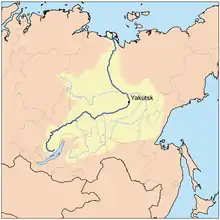Vitim (river)
The Vitim (Russian: Витим; Evenki: Витым, Witym;[1] Yakut: Виитим, Viitim [local pronunciation];[1] Buryat and Mongolian: Витим, Vitim[1]) is a major tributary of the Lena. With its source east of Lake Baikal, the Vitim flows north through the Transbaikal Mountains and the town of Bodaybo. Including its source river Vitimkan, it is 1,978 kilometres (1,229 mi) long, and has a drainage basin of 225,000 square kilometres (87,000 sq mi).[2][3][4] The river peaks in June and freezes from November to May. It is navigable from the Lena to Bodaybo. Upstream, tugs can haul barges as far as the Baikal Amur Mainline (BAM), but this is becoming rare. Formerly, because of its swift current, goods were hauled 144 kilometres (89 mi) overland from Chita to a place called Romanovka. There boats were built, floated down the river, and broken up at their destination. This lasted until the late 1940s. The Vitim is an excellent place for adventure rafting, but is rarely visited because of its isolation.

| Vitim | |
|---|---|
 The Vitim near its tributary Bambuyka | |
 Lena watershed | |
| Native name | bxr,Витим мγрэн,evn,Видым |
| Location | |
| Country | Russia |
| Region | Buryatia, Irkutsk Oblast, Sakha Republic, Zabaykalsky Krai |
| Cities | Bodaybo, Vitim, Mama, Russia |
| Physical characteristics | |
| Source | |
| • location | Ikat Range, Irkutsk Oblast |
| • elevation | 1,171 m (3,842 ft) |
| Mouth | Lena |
• coordinates | 59.4631°N 112.6013°E |
| Length | 1,940 km (1,210 mi) |
| Basin size | 225,000 km2 (87,000 sq mi) |
| Discharge | |
| • average | 2,149 m3/s (75,900 cu ft/s) |
| Basin features | |
| Progression | Lena→ Laptev Sea |
| Tributaries | |
| • left | Tsipa, Muya, Mamakan, Mama |
| • right | Konda, Karenga, Kalakan, Kalar, Bodaybo |
The first Russian to explore the river was probably Maksim Perfilyev in 1639–40, who brought back reports of the upper Amur River.[5]
Baissa, one of the famous localities of fossil insects is situated on the left bank of the Vitim River.
Course

Going upstream: Vitim town where the Vitim joins the Lena. Mama and Mama Airport, about 130 kilometres (81 mi) south of Vitim. A muscovite mica mine from 1705 until the late 1930s. Now a small settlement. Mamakan, on a west-flowing stretch 200 kilometres (120 mi) south-southeast of Vitim. In 1961 a 86MW dam on a left tributary was completed, one of the first dams built on permafrost. Bodaybo, just upstream, a gold mining center founded in 1864. Upstream, the port of Luzhki was the start of a road to the Lena gold fields. From here upstream the river goes crookedly east and then south. About 240 kilometres (150 mi) upstream from Bodaybo are the Uronsky Rapids and after 140 kilometres (87 mi) more, the Parama Rapids. About 40 kilometres (25 mi) or so upstream, the Vitim is crossed by the Baikal Amur Mainline between Taksimo and Kuanda. Upriver there are more rapids and goldfields. South through the Stanovoy Mountains toward Chita, then west into the Vitim Plateau east of Lake Baikal.[6]
Vitim event
An event called the Vitim event on September 25, 2002, occurred in the Vitim River basin near Bodaybo. The event was probably caused by a bolide. The event was similar to Tagish Lake.
References
- "KNAB, the Place Names Database of EKI". Eki.ee. Retrieved January 1, 2013.
- Витим (река в Бурят. АССР), Great Soviet Encyclopedia
- Река ВИТИМ in the State Water Register of Russia (Russian)
- Река ЧИНА in the State Water Register of Russia (Russian), Vitimkan erroneously called China
- Lantzeff, George V., and Richard A. Pierce (1973). Eastward to Empire: Exploration and Conquest on the Russian Open Frontier, to 1750. Montreal: McGill-Queen's U.P.
- Yates and Zvegentzov,'Siberian BAM Guide',2001